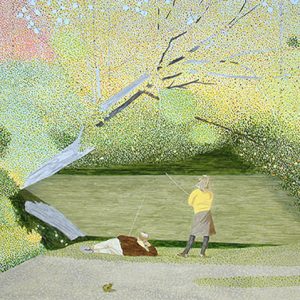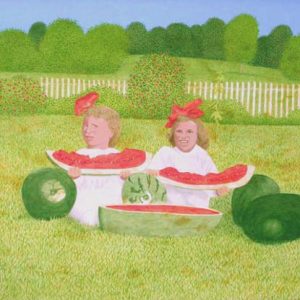calsfoundation@cals.org
Carroll James Cloar (1913–1993)
Carroll James Cloar was a painter who earned national acclaim as a realist and surrealist. The majority of his works had conceptual ideas based on his memories from his childhood in east Arkansas. His paintings are characterized by flattened figures in landscapes formed of decorative patterning. One of his paintings was chosen to be among six paintings by American artists commemorating President Bill Clinton’s inauguration in 1993.
Carroll Cloar was born on January 18, 1913, on a farm approximately ten miles north of Earle (Crittenden County). The son of Charles Wesley Cloar and Julia Eva Cloar, he had three brothers and one sister. He spent his childhood on his parents’ cotton farm.
At the age of seventeen, Cloar moved to Memphis, Tennessee, and earned a BA in English at Southwestern College (now Rhodes College). After graduating in 1934, he traveled to Europe for a carefree vacation, then returned to Memphis and enrolled at the Memphis Academy of Art. There, he studied with painter George Oberteuffer. In 1936, he moved to New York and attended the Art Students League in New York City, studying under Arnold Blanch, William McNulty, and Harry Sternberg. Cloar focused on drawing, with an ambition to be a comic strip artist. Teacher Ernest Fiene gave him his first experience with oil painting. It was at this time that Cloar also became interested in lithography, a printing method that allows the artist to draw on a flat stone.
From 1938 to 1940, Cloar worked from family photos to create a series of lithographic prints. One of these prints was chosen for showing in the Art in America Building for the 1939–40 New York World’s Fair. On the basis of these lithographs, the Art Students League awarded Cloar a McDowell Traveling Fellowship in 1940. Cloar used the grant to finance a journey through the western United States and Mexico. He had showings of his art in Denver, Colorado; Salt Lake City, Utah; and Salem, Oregon. While staying in Mexico City in 1941, Cloar started bringing his vague conception of his Arkansas heritage into focus. He created some lithographs and did a few paintings, none of which satisfied him. In later years, Cloar would burn many of his early works, including most of what he did in Mexico City.
At the start of World War II, he joined the U.S. Army Air Corps. He was shipped to Saipan in the Pacific Ocean, where he worked in communications and did odd jobs when he was not needed on the radio. He painted a mural for the enlisted men’s club—a “history” of his B-29 squadron. For a stipend, he would paint pin-up girls on the noses of bombers. None of his work from this period survives.
In 1946, Cloar won a Guggenheim fellowship, and again he used the money to travel, returning to Mexico and continuing throughout Central and South America. A 1948 Life magazine spread on him, titled “Backwoods Boyhood” and illustrated with his autobiographical lithographs, gained him national fame. In 1953, he returned to Memphis and produced his first one-man exhibit, having created fourteen paintings that year. The next year, he went back to Europe to study, visiting Italy and Spain. When he returned to Memphis in 1955, he settled in the city, though he continued to travel in South America through 1959.
Cloar continued to produce paintings for the rest of his life, working in casein tempera—and later acrylic—on large canvases, depicting images drawn from photographs and his own memories. Cloar’s work almost always contains a strong narrative strain, and even if the story being told is not straightforward, its power can be sensed in the mysteriousness of the circumstances, whether that be a tree full of panthers or a football team lining up against an unseen opponent. His style has been described as both primitive and progressively modern. It is grounded in reality and touched by surrealistic, or dream-like, overtones, as in the work Hostile Butterflies, in which four children run toward a house in the distance while butterflies and leaves swirl around the foreground of the painting, a seemingly innocent scene with a strangely ominous sense about it. Cloar’s work is so difficult to categorize that scholars began to describe it as within the genre of “magic realism.” In the 1977 catalog of his work, titled Hostile Butterflies and Other Paintings, essayist Guy Northrop notes that Cloar tackled the themes of “birth, life and death, of the family, friends, work, school, religion, man’s relationships to other men and to nature, of hopes and dreams and faith, or memories and desires, of virtues and morality, sin and failure, of fears and anxieties, hardships, love, pleasures, rewards and intermezzos—all these are universals.” Cloar described his images as “American faces, timeless dress and timeless customs…the last of old America that isn’t long for this earth.”
In 1960, Cloar launched into a series of six parodies that played on the styles of more famous artists, such as Abstract Expressionist painter Willem de Kooning, Pacific Coast mystic Morris Graves, surrealist Yves Tanguy, and abstractionist Piet Mondrian. From the 1960s to the 1980s, he continued to paint in his distinctive style, creating some of his most famous paintings, including Where the Southern Cross the Yellow Dog (1964), a painting that references W. C. Handy’s famous “Yellow Dog Blues.” In 1969, Cloar heard about the death of an elderly African American photographer in Earle. He visited the man’s widow, and she let him take what he wanted from her late husband’s work. Cloar used these photographs as inspiration for his work over the next twenty years.
In 1991, the University Gallery at Memphis State University (MSU—now the University of Memphis) displayed seventy of his works, including lithographs, paintings, and drawings. Also at this time, he received the Distinguished Achievement Award for Creative and Performing Arts from MSU. From November 1992 to January 1993, the Brooks Museum of Art in Memphis presented Playing Favorites, an exhibition containing twenty-five works that Cloar selected. As the exhibition closed in January 1993, Cloar’s painting Faculty and Honor Students, Lewis Schoolhouse was chosen to be among six paintings by American artists commemorating President Bill Clinton’s inauguration.
On April 10, 1993, Cloar died from a self-inflicted gunshot wound after a long battle with cancer. He was survived by his wife, Patricia. His body was cremated and his ashes scattered across his old home place in Earle.
Institutions holding Cloar’s works include the Arkansas Museum of Fine Arts in Little Rock (Pulaski County), Crystal Bridges Museum of American Art in Bentonville (Benton County), the Hirshorn Museum and Sculpture Garden in Washington DC, the Brooks Museum of Art in Memphis, the New York Metropolitan Museum of Art, the Crittenden County Museum, the Museum of Modern Art in New York, the Library of Congress, Chase Manhattan Bank, and the Whitney Museum.
For additional information:
Art Museum of the University of Memphis. Carroll Cloar: In His Studio. Jackson: University Press of Mississippi, 2014.
Bradbury Gallery Holdings. Fowler Center. Arkansas State University, Jonesboro, Arkansas.
Cloar, Carroll. Hostile Butterflies and Other Paintings. Introduction by Guy Northrop. Memphis: Memphis State University Press, 1977.
Obituary of Carroll Cloar. New York Times, April 13, 1993. Online at http://www.nytimes.com/1993/04/13/obituaries/carroll-cloar-a-realist-painter-of-rural-america-is-dead-at-80.html (accessed July 11, 2023).
Masler, Marilyn. “Carroll Cloar.” The Tennessee Encyclopedia of History and Culture. https://tennesseeencyclopedia.net/entries/carroll-cloar/ (accessed July 11, 2023).
Thomas, Stanton. The Crossroads of Memory: Carroll Cloar and the American South. Exhibition catalogue. Little Rock: Arkansas Arts Center, 2014.
Erin Branham
Arkansas Arts Center
 Arts, Culture, and Entertainment
Arts, Culture, and Entertainment Fishing (Anglers II) by Carroll Cloar
Fishing (Anglers II) by Carroll Cloar  Watermelon Girls
Watermelon Girls 




Comments
No comments on this entry yet.